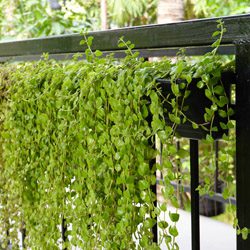Is it possible to nurture a thriving urban garden when your garden space is simply just a narrow passage, stunted landing, and metal railings of a fire escape? Indeed, it is! Fire escape gardening can be fare more pleasant and productive than you may realize, if you adapt your gardening techniques to the unique challenges of the space.
Before You Begin
Before you plan an elaborate garden setup on your fire escape, check your building’s restrictions and local regulations about fire escape gardening. In many areas, storing items – including gardening supplies and plants – on a fire escape is not allowed, and you could be subject to fines, loss of insurance coverage, and other penalties for violating those restrictions, even up to facing eviction. If minimal use of the space is permitted, always be certain to leave an obvious aisle clear and do nothing to impede movement through the space or the functioning of any gates, hatches, ladders, or other equipment that is part of the fire escape’s main function. Different buildings and municipalities may have different codes covering fire escape use and gardening, and always follow the appropriate laws and guidelines.
Tips for Fire Escape Gardening
After doing your homework, if you are permitted to use your fire escape for a garden space, it can be a creative and unique challenge to stretch your gardening skills. To make the most of your fire escape and nurture a thriving garden…
- Keep It Light – You don’t want to fill your fire escape with large, heavy concrete or ceramic pots. Not only can they be difficult to work with, but if one should fall, it could create not only a mess, but significant damage as well. Instead, consider lighter plastic pots, cloth pots, or other unique containers, such as wellingtons, woven baskets, or mesh structures with lightweight liners.
- Be a Minimalist – Avoid overcrowding your fire escape with a burgeoning jungle, and instead opt for compact plants that will do well in small spaces. Ultimately, you should still see more metal than green in a fire escape garden, ensuring that that space remains safe and usable in case of an emergency.
- Embrace Mobility – Opt for containers and plants that you can move quickly if necessary, not just in case of emergency, but to maximize the efficiency of your garden. Movable pots or plant stands with casters can be rearranged to make the best use of seasonally shifting sunlight or can be moved indoors during storms or the colder winter months.
- Make the Most of the Railing – Your fire escape railing can be prime real estate for gardening efforts. Use planters mounted on the railing or that can hang over the side. You may also use macramé hangers to hang small pots between support rails. Take care not to block essential handrail space, however, which can be necessary for a safe descent in an emergency.
- Be Aware of Neighbors – Be mindful of the neighbors who share your fire escape, especially those directly below, when you water your plants. Either bring your plants inside to water them in a sink or be sure to water at time when it will not bother others.
- Keep Away Unwanted Guests – Even gardens in the most urbanized areas can attract squirrels, as well as other tenacious wildlife such as mice, pigeons, and rats. Takes steps to keep these unwanted visitors away from your garden with mesh barriers and other deterrents, such as using organic bloodmeal fertilizers to discourage visits.
Best Plants for a Fire Escape Garden
Ultimately, you can grow anything in a fire escape garden that you would grow in any urban garden space, provided you have the sunlight levels and suitable size growing area to accommodate the plants. Because fire escape gardens can be so small, however, you may want to concentrate your efforts on the plants you will eat and enjoy the most, particularly small cultivars that are well adapted to urban conditions. Leafy greens such as kale, lettuce, and spinach are top choices, as are bush varieties of beans, peppers, and tomatoes. Different berries can add a sweet touch to your fire escape garden, and flavorful herbs are always a favorite to add tantalizing tastes to everything you grow.
Moving Your Garden
Regardless of the size of your fire escape garden or what you’ve chosen to grow, always be aware that you may need to move your plants on short notice. This could be due to changes in building codes or fire regulations, or you may simply be moving and want to transport your garden as you relocate, hopefully to a new residence that will provide even more growing space. Move your plants gently and thoughtfully, and they will be happy to relocate along with you.









